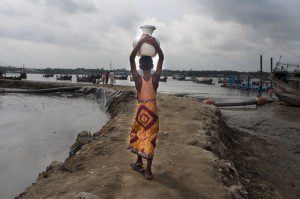 Time to evaluate fresh water footprint for tackling water crisis in Bangladesh The world water resources, or the lack of them, have become severe crises over the past few decades, due to increases in population and urbanization, environmental transformation such as an extra-ordinarily changing climate, unfriendly economic development activities, and increases in water appropriation. The Universal Declaration of Human Rights delivered addressed every conceivable rights of importance to those who wrote it; property, government, marriage, legal rights and so on.
Time to evaluate fresh water footprint for tackling water crisis in Bangladesh The world water resources, or the lack of them, have become severe crises over the past few decades, due to increases in population and urbanization, environmental transformation such as an extra-ordinarily changing climate, unfriendly economic development activities, and increases in water appropriation. The Universal Declaration of Human Rights delivered addressed every conceivable rights of importance to those who wrote it; property, government, marriage, legal rights and so on.
But access to the commons of clean and safe drinking water is not mentioned. Moreover, one of the substantial steps taken by the international community has been formulation of the Millennium Development Goals (MDGs). Specific targets include reduction by half the proportion of people without sustainable access to safe drinking water by 2015.The short-coming of the Millennium Development Goals is that they lack a definite course of action and a mechanism for enforcement. In 2002, the Committee on Economic, Social and Cultural Rights of the United Nations specified the right to water in its General Comment No: 15. It says, “The human right to water entitles every one to sufficient, safe, acceptable, physically accessible and affordable water for personal and domestic uses. An adequate amount of safe water is necessary to prevent death from dehydration, to reduce the risk of water related disease and to provide for consumption, cooking, personal and domestic hygienic requirement”. In this regards in 2003, at the World Water Forum conference, Former Russian President Mikhail Gorbachev urged enshrinement of the right to water in the UDHR. Recently the U.S National Intelligence Council’s Global Trends Report-2025, has predicted that “Cooperation to manage changing water resources is likely to become more difficult within and between states in Asia.”
In addition, the undergoing implementation of several dams and hydropower projects of India, which are in violations of the 1960 Indus Waters Treaty, ushers in the possibilities of imminent water crises in south Asian region. Safe, clean and fresh water is vital for every form of life as well as human body. Human body can survive few days without food, but cannot survive for long without drinking water. Today, 1.10 billion of the world’s people will be drinking filthy water laden with pathogenic micro-organisms. One out of every six people does not have adequate access to safe water. Besides, the United Nations projects report said that three out of four people around the world could be affected by severe water scarcity by 2050. This adds to the burden of infection, loss of their working hours, income generation, ill-health, and death of communities. Zafar Adeel, who is the director of the United Nations University’s Institute for Water, Environment & Health and former chair of UN-Water, speaking at the sixth World Water Forum at Marseille in France in 2012 said that the globally integrated Environmental Assessment Modeling initiative of a decade or so ago led him to offer caution around the task of bringing together data that is on very different geographic and time scales on global context. That poses a very serious challenge for scenario builders where one is trying to integrate social information with climate and water information which is at a very different scale.
In 2002, the concept of water footprint as an indicator of water use was initiated that takes the perspective of consumption. The idea was that water footprint indicator could provide useful information in addition to the traditional indicator of water use, which takes the perspective of production. The water footprint of a nation is defined as the total volume of fresh water that is used to produce the goods and services consumed by the people of that nation, since not all goods consumed in one specific country are produced in that country. The water footprint of national consumption can be calculated in two ways. The approach is to consider the sum of all products consumed multiplied with their respective product water footprint.
In words, the water footprint of national consumption is calculated as the total use of domestic water resources plus the gross virtual water import minus the gross virtual water export. The water footprint of consumption in a country counts on two forms of factors. What and how much do consumers consume and what are the water footprints of the commodities consumed. The latter counts on the production circumstances in the places of origin of the various commodities, very low agricultural yields, and associated large water footprints per unit of harvested crop in some developing countries Including Bangladesh explains why some poor countries have a relatively large water footprint of national consumption.
The global average water footprint was 1385 cubic meters/year per capita in the period 1996-2005. Fresh water crises are particularly acute in Asia. Though Asian countries are home to more than half of the world’s population, it has less fresh water average than any other continent. In this regards, Maldives is the country with largest average water footprint in the south Asian countries, with water footprint of 1361 cubic meters/year per capita. On the contrary, Bangladesh is the country with lowest average water footprint in the south Asian countries, with average footprint of 769 cubic meters/year per capita. Among other countries in this region, Pakistan has 1331, Srilanka 1256, Nepal 1201, and India has 1089 cubic meter/year per capita. In this region, India contributes about 18 percent to the global population and the people of India contribute about 14 percent to the global water footprints.
On a relative basis it is the people of USA who have the largest water footprint with 2842 cubic meters/year per capita, followed by the people in south European countries, such as Greece, Italy, and Spain (2300-2500) cubic meters/year per capita. Over all, in the Asian region, large water footprints can be found in Malaysia (2103 cubic meters/year per capita) and in Thailand (1407 cubic meters/year per capita). Lastly, the Peoples’ Republic of China has a relatively small water footprint to its population with an average of 1071 cubic meters/year per capita. Sustainable development in the wider sense of the term means building communities across the world for living healthy lives comfortably within a better environment keeping ecological balance all the way. The current global water footprint is 9087 giga cubic meters/year which, in many places, obviously leads to unsustainable conditions, as witnessed by the many reported cases of water depletion and pollution. Even if the annual volume of precipitation overland is roughly known, it is very difficult to give a global figure for the maximum sustainable water footprints as an upper limit to global water use.
Relevant: WATER CRISIS IN BANGLADESH: CHALLENGES AND SOLUTIONS
In Bangladesh, the Water Resources Planning Organization (WARPO) under the Ministry of Water Resources is the prime government institution for macro-level planning for management and integrated development of water resources of the country. Meanwhile, it has prepared the national water management plan within the framework of national water policy to support a framework at national and regional levels linking with line agencies and other stakeholders’ plan and to implement projects according to their mandates in a coordinated and integrated manner. Whatsoever, we have to take some steps towards sustainable development for conservation of water resources, an equitable management and also sharing of water resources which is essential for global community as well as local community.
In our country, this challenge to make resources more productive without ecological damage requires some steps which are as follows: (a) Proper wetland management including coastal areas of the Bay of Bengal. (b) Preparation of water footprint database and evaluation of national water footprint. (c) Implementation of efficient private water management and always keeping an eye on national self-interests. (d) Establishment of operational working group on water quality criteria. (e) Identification of pollution-origins, sources, quantity of pollutants, wastes and hazardous chemicals. (f) Reclamation of sewage and waste water, pollution control, abatement and rehabilitation. (g) Development of ground water sources and surface storage activities. (h) Strengthening Institutional co-ordination and Environmental Impact Assessment (EIA) study. (i) Implementation of the National Water Policy-1997 and Review for upgrading this policy. (j) Public awareness and advocacy at national & regional level. (k) Implementation of the commitments to the 2005-2015, International Decade for Action, “Water for Life”. (l) Enforcement and implementation of existing environmental regulations and the environmental conservation act.
The writer is a botanist and researcher. Firsh published in FAIR magazine.Issue 4







